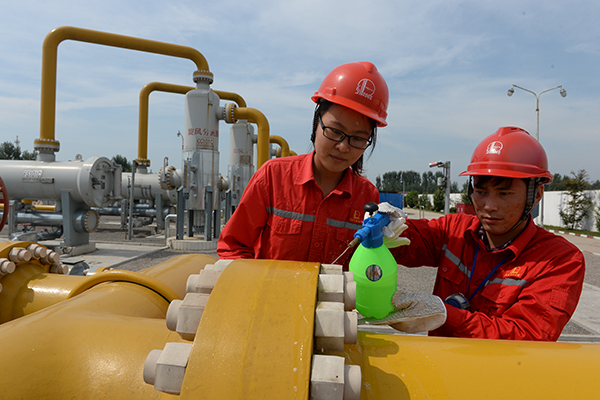Big companies not necessarily strong
(China Daily) Updated: 2016-07-25 07:28
 |
|
Sinopec employees inspect natural gas pipelines in Zibo, Shandong province. [Photo/CFP] |
A hundred and ten Chinese companies made the latest Fortune Global 500 list, almost double the number from Japan. Twelve of them made their debut, including manufacturing powerhouse China Railway Rolling Stock Corp and property developer Wanda. Beijing News commented on Saturday:
The latest Fortune Global 500 list illustrates the fact that with Asian, especially Chinese companies, evolving into multinational giants, Western companies no longer dominate the global marketplace. But it also reveals the problems, such as structural imbalances, inefficient profitability, and high concentration of resources, with many Chinese enterprises.
To be specific, most of the listed Chinese companies are still in traditional sectors, such as energy, banking, and real estate.
Likewise, thanks to favorable domestic policies, four of those that made their first appearance on the list are defense enterprises, with another three property developers. The latter's rise, in particular, cannot be sustained against the backdrop of nationwide efforts to clear the real estate glut.
Besides, the size of many Chinese companies that made the list does not match their profitability. In other words, most of them, especially those in traditional industries, have poor performance in comparison to their counterparts in emerging industries. That the State-owned energy giant China National Petroleum Corp, which ranked high on the list, has lost over 13.7 billion yuan ($2.04 billion) in the first quarter of this year, is a case in point.
In fact, it is domestic monopolies and preferential policies that have helped many Chinese enterprises secure a place on the list. Among all Chinese companies ranking in the top 100, only one-Shenzhen-based Pingan Group-is not affiliated to the government.
Monopolistic, traditional companies keep tightening their control over certain resources and markets, leaving little room for those in the emerging industries. The country's robust growth can only be sustained if the innovation-driven economy grows bigger and replaces the obsolete industries, and more resources are allocated to profitable enterprises. That requires more efforts to break the institutional barriers and level the playing field for both State-owned and private players.
- Top 12 Chinese firms debuted in 2016 Fortune Global 500
- 110 of nation's firms on Fortune Global 500 list
- Chinese company Hisense reaps benefits from Euro 2016 sponsorship
- Chinese company applies for feasibility of Nepalese railway
- Chinese company to supply more trains for Bangkok Skytrain
- Chinese company to enter Serbia's wind energy market
- Chinese company rolls out extra-large film screen
- Chinese company helps Botswana employee realize house dream
- Chinese company plans to sell its 50% share in Microsoft Online












